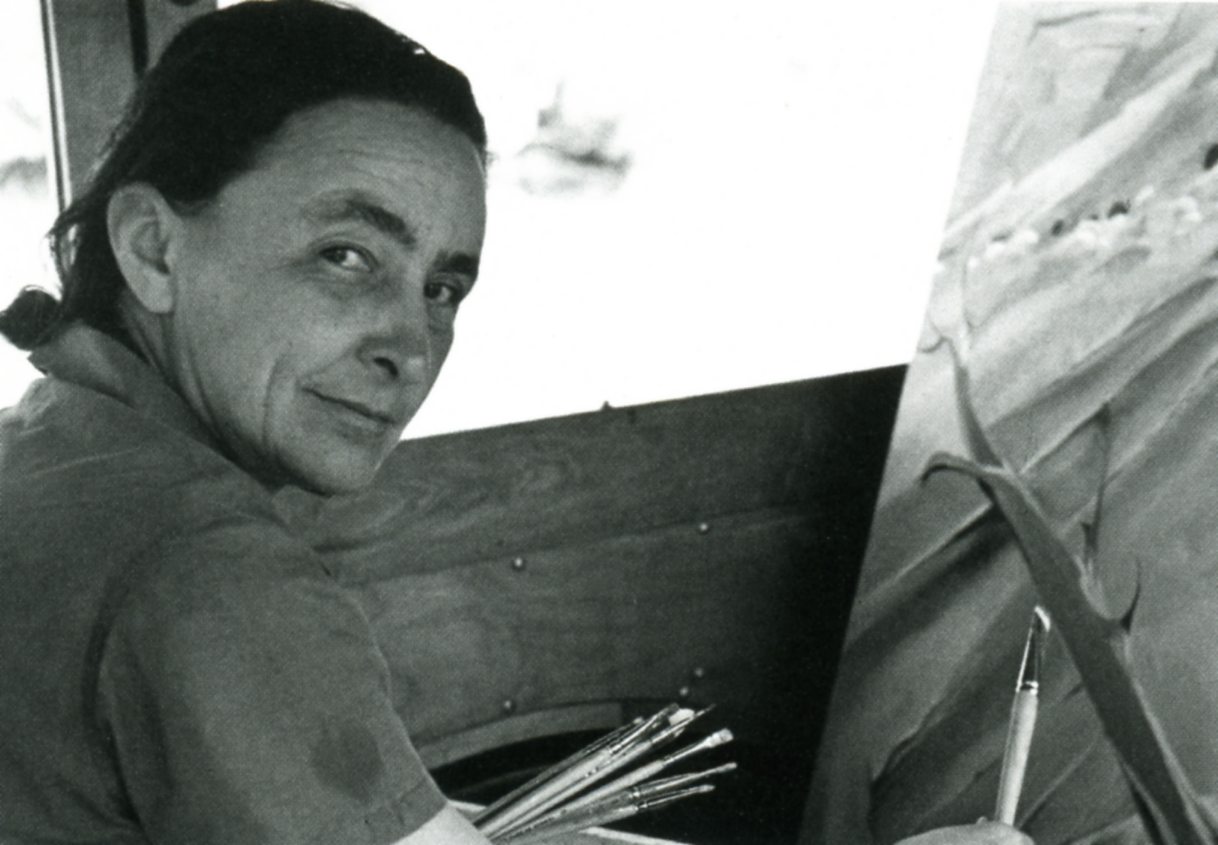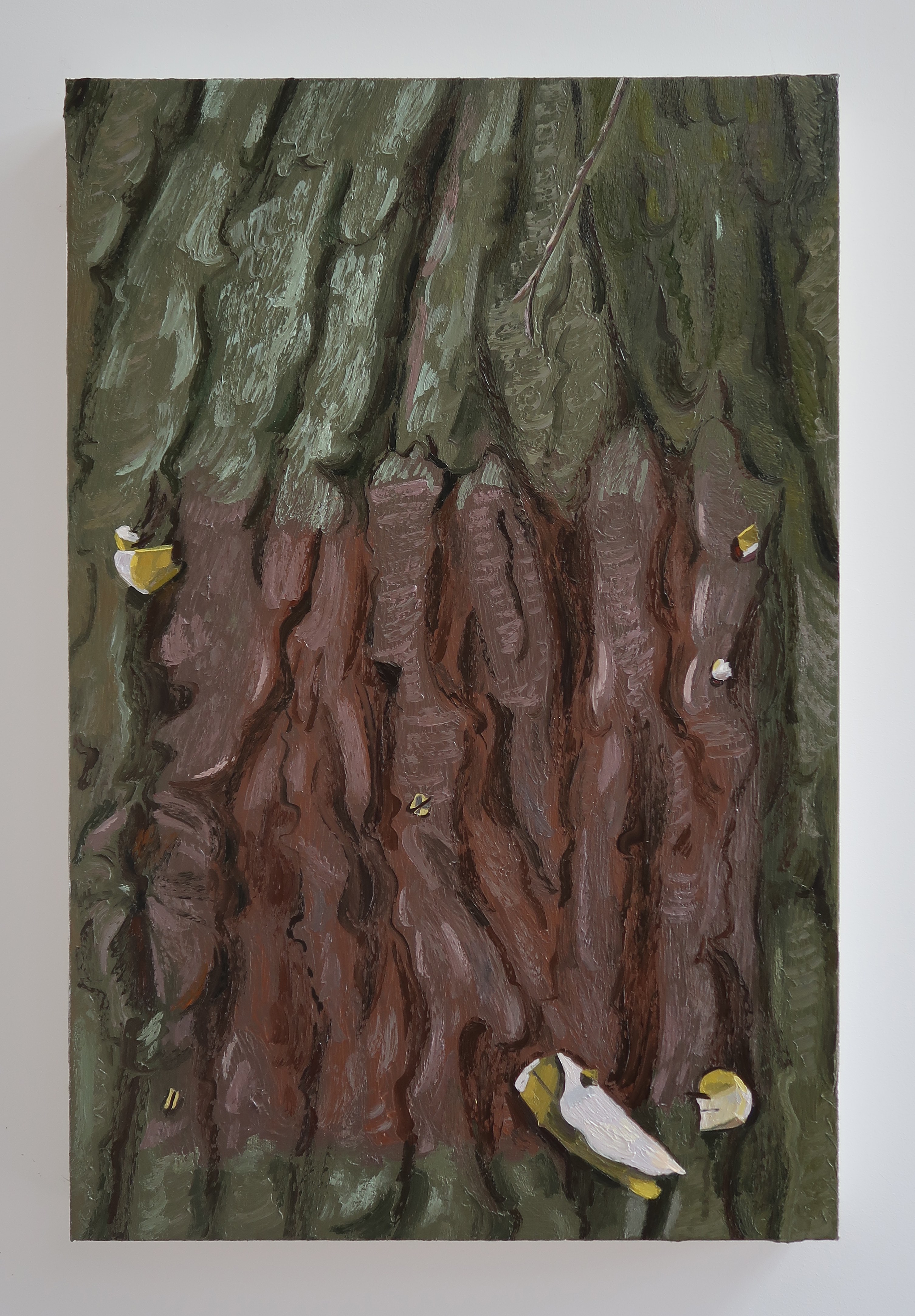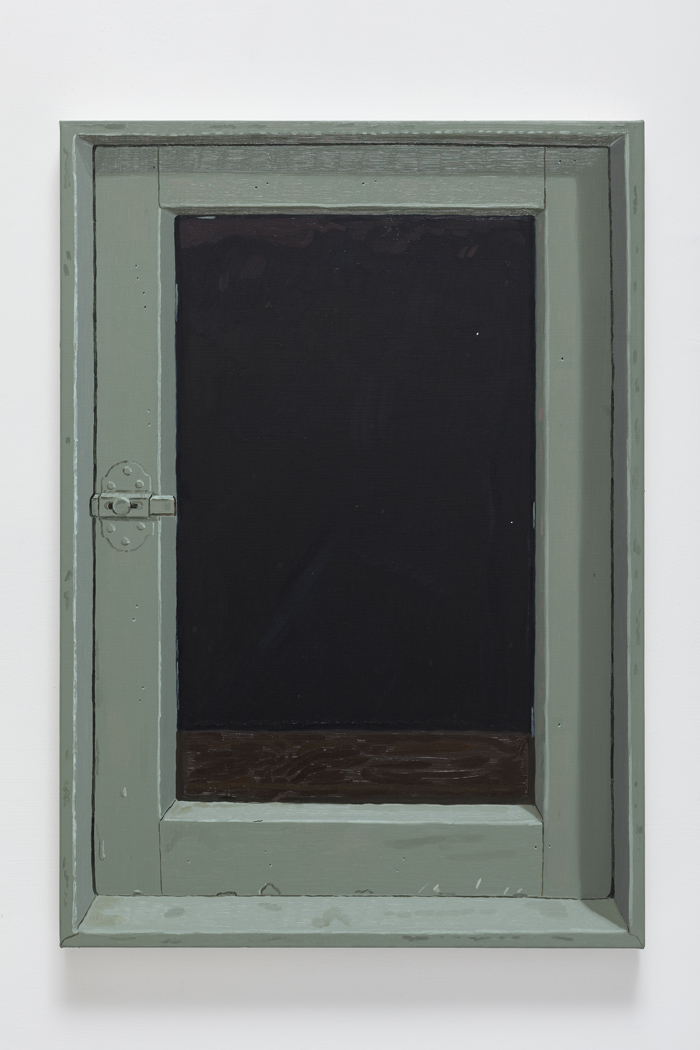Place and Presence
- Ariel Plotek, Curator of Fine Art, Georgia O'Keeffe Museum
In the summer of 2019, Josephine Halvorson set out from Massachusetts to Northern New Mexico. It was the first time that the Georgia O’Keeffe Museum would host an artist-in-residence, and Halvorson had chosen to work at O’Keeffe’s Ghost Ranch home, about 50 miles northeast of Santa Fe. The larger Ghost Ranch property, within which O’Keeffe’s home sits, was a “dude ranch” where tourists played at riding horses and roping steers in the 1930s and 1940s. The gate to the larger property still bears the mark of the artist: the cow’s skull she drew for the ranch’s logo. Equally emblematic is the picture snapped in 1944 by Maria Chabot of Georgia O’Keeffe hitching a ride across the badlands near Ghost Ranch with her friend Maurice Grosser [Figure 1].
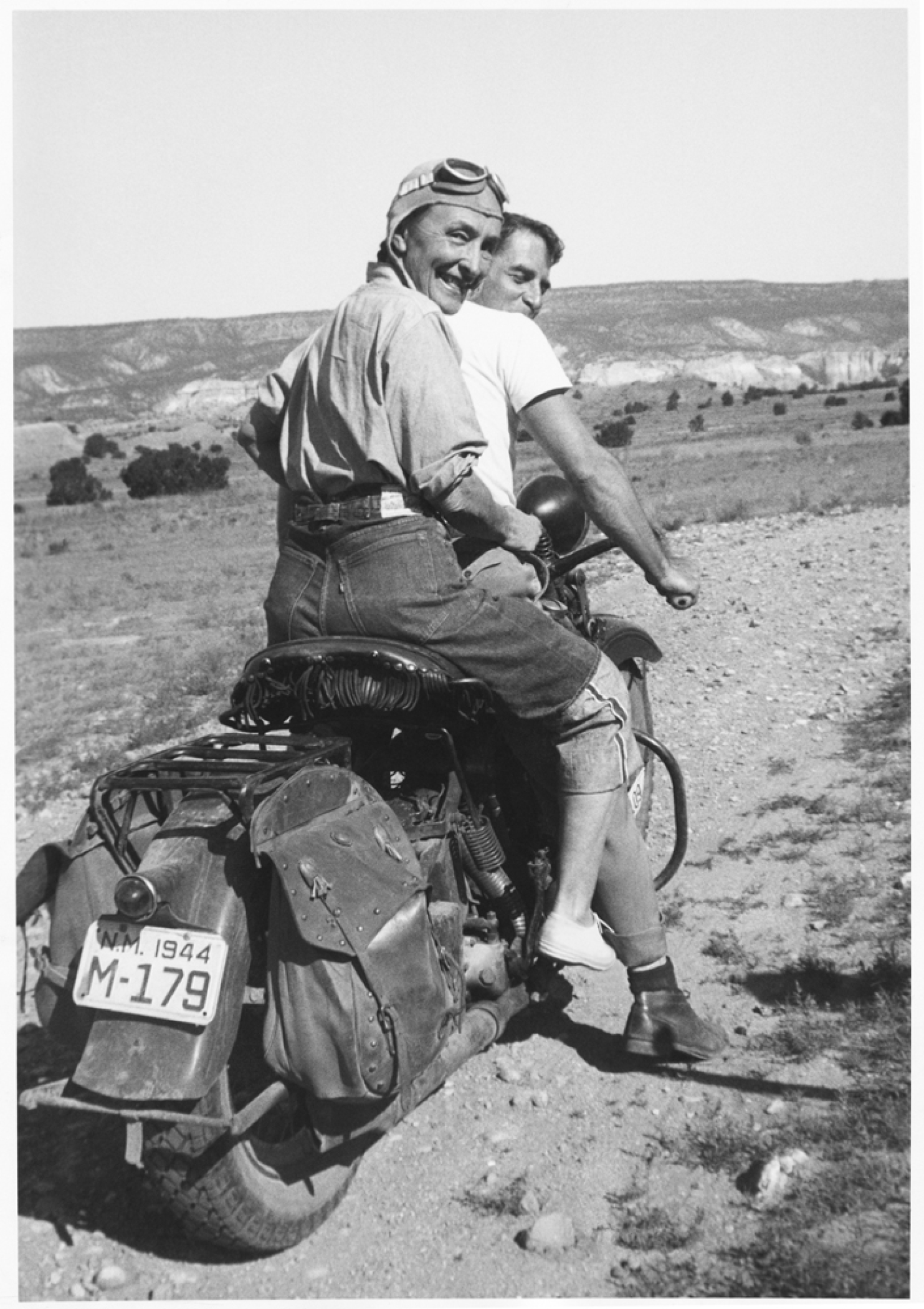
A fellow east-coast transplant, Grosser would go on to make his name as an art critic with a book, The Painter’s Eye, first published in 1951. In a chapter debating the merits of painting versus photography, Grosser begins with the nineteenth-century origins of the latter—stressing the affinity between photography and the school of painting that we call Impressionism. In pursuit of “Truth,” Grosser suggests, these painters of modern life had turned to working out-of-doors, capturing their subjects with the same immediacy as a camera.
Josephine Halvorson, like Georgia O’Keeffe, is not a follower of any school. Nevertheless, she does work out-of-doors—in front of the subject. O’Keeffe, in contrast, preferred the solitude of her studio. Still, she did occasionally paint outside. In a documentary of 1977, produced on the occasion of the artist’s ninetieth birthday, O’Keeffe recalls how, by turning around one of the front seats of her Model A Ford, she was able to convert the car into a studio on wheels. A photograph by Ansel Adams of 1937, taken near her Ghost Ranch home, testifies to this practice, depicting the painter at work before this makeshift easel [Figure 2]. In New Mexico, O’Keeffe joked about painting the “Great American Painting,” and what could be more American than painting in the back of a car? She had only recently learned to drive, affording herself a freedom that would become symbolic of the “American Century.”
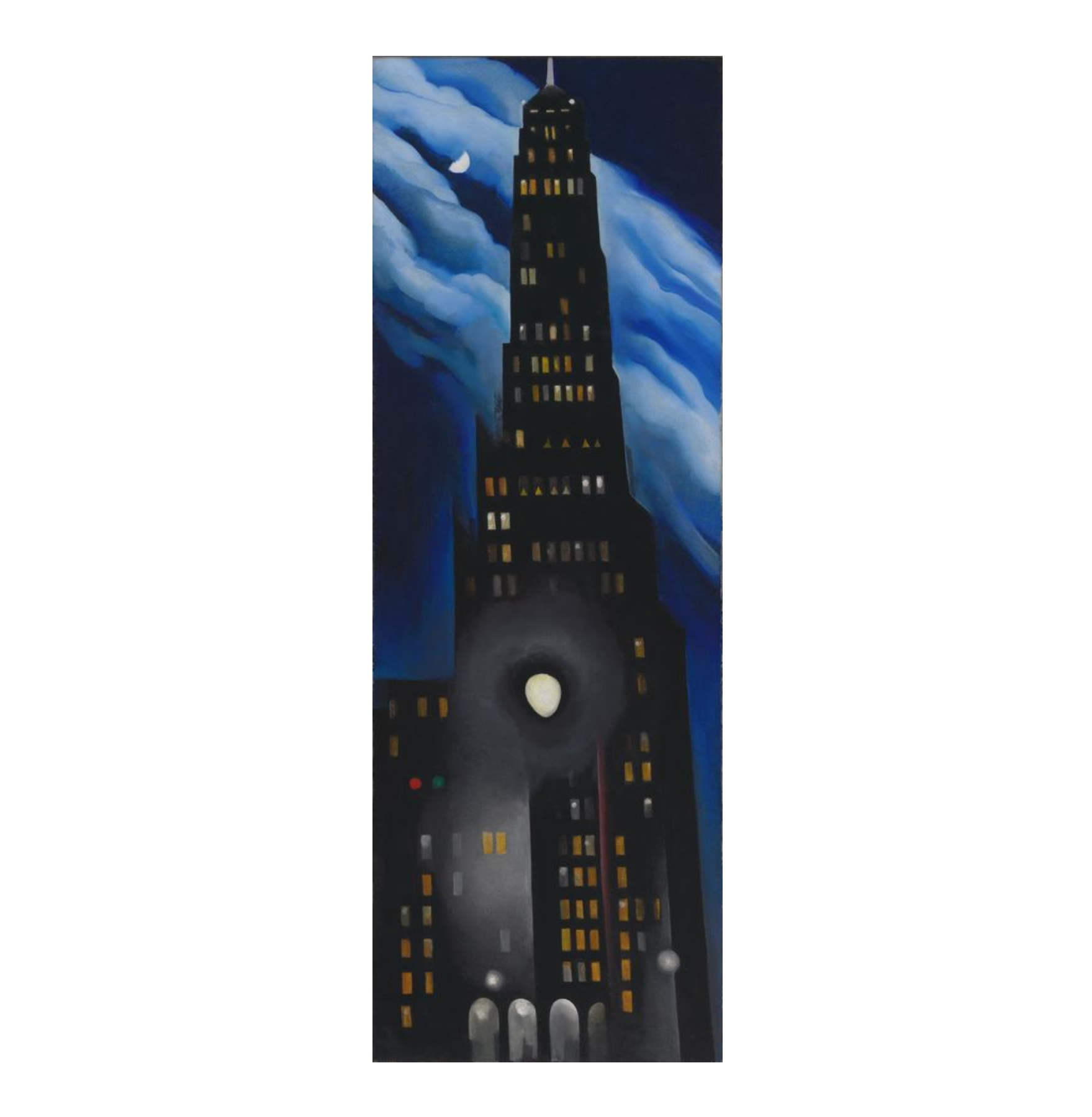
In contrast to this forward-looking Modernism, Halvorson looks back on the twentieth century. In her education in New York at the turn of the twenty-first century, Halvorson came of age at a time when painting had already been pronounced “dead.” Small wonder that she turned to painting eulogies; images of obsolete tools in equally outmoded and abandoned settings. Like the Impressionists, O’Keeffe had painted feats of modern engineering [Figure 3]. Halvorson’s subjects are postmodern in the true sense of the word; images of furnaces grown cold and machinery left to rust.
More recent paintings by Halvorson move the artist’s close-focus vision to the natural world, as in the series As I Went Walking, executed in the woods surrounding the artist’s home in Western Massachusetts. The dense forest depicted in these works clashes in places with the time-worn signs of human habitation, and the subjugation of nature as private property, such as a tree marked with spray paint or a “No Trespassing” sign. Oil paintings such as Ghost (2017) are life-sized [Figure 4], and executed outdoors as a function of daylight and weather. In this case, a tree trunk retains the “ghost” of an old sign, still stapled at the corners. It is a meditation on the passage of time, as well as the specificity of place.
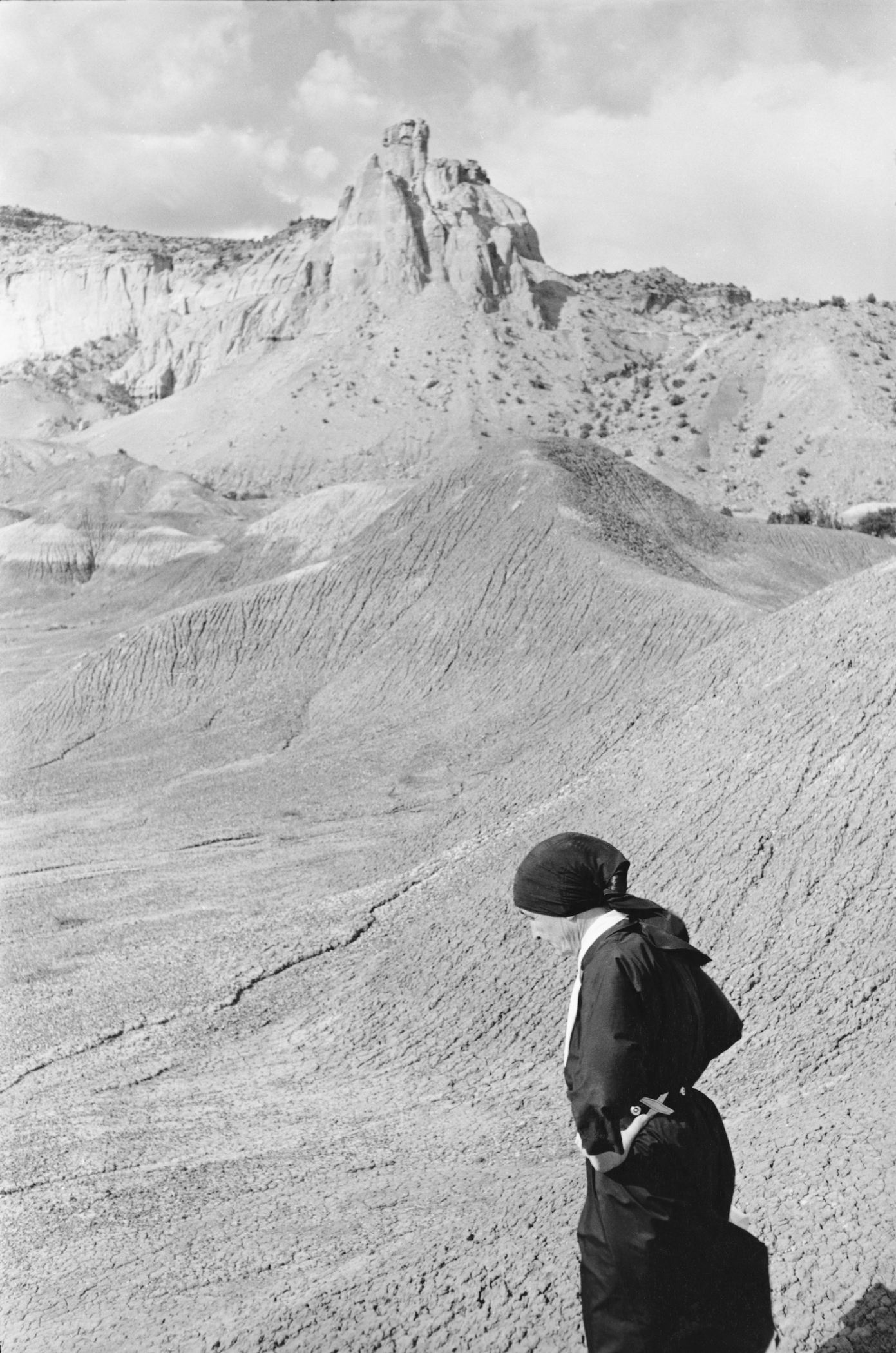
O’Keeffe’s voluminous correspondence allows us to locate many of her paintings with unusual precision. Letters from Texas, for instance, beginning in 1916, tell of camping trips at Palo Duro, and the places where she painted the sky at night, and a train as it crossed the plains. It was a connection, an attachment to the land, that she would not feel again until her first summer in New Mexico in 1929. Decades later, this image of the artist in the landscape would be immortalized by photographers like Tony Vaccaro, who accompanied O’Keeffe on her long walks [Figure 5]. In the same way that O’Keeffe had begun picking up bones that first summer in Taos, found objects that she arranged in her studios, she would never tire of collecting stones. Whether chipped from a mountain, or worn in a river, each rock could function doubly: as tangible piece of the vast landscape, and as a still life subject in its own right.
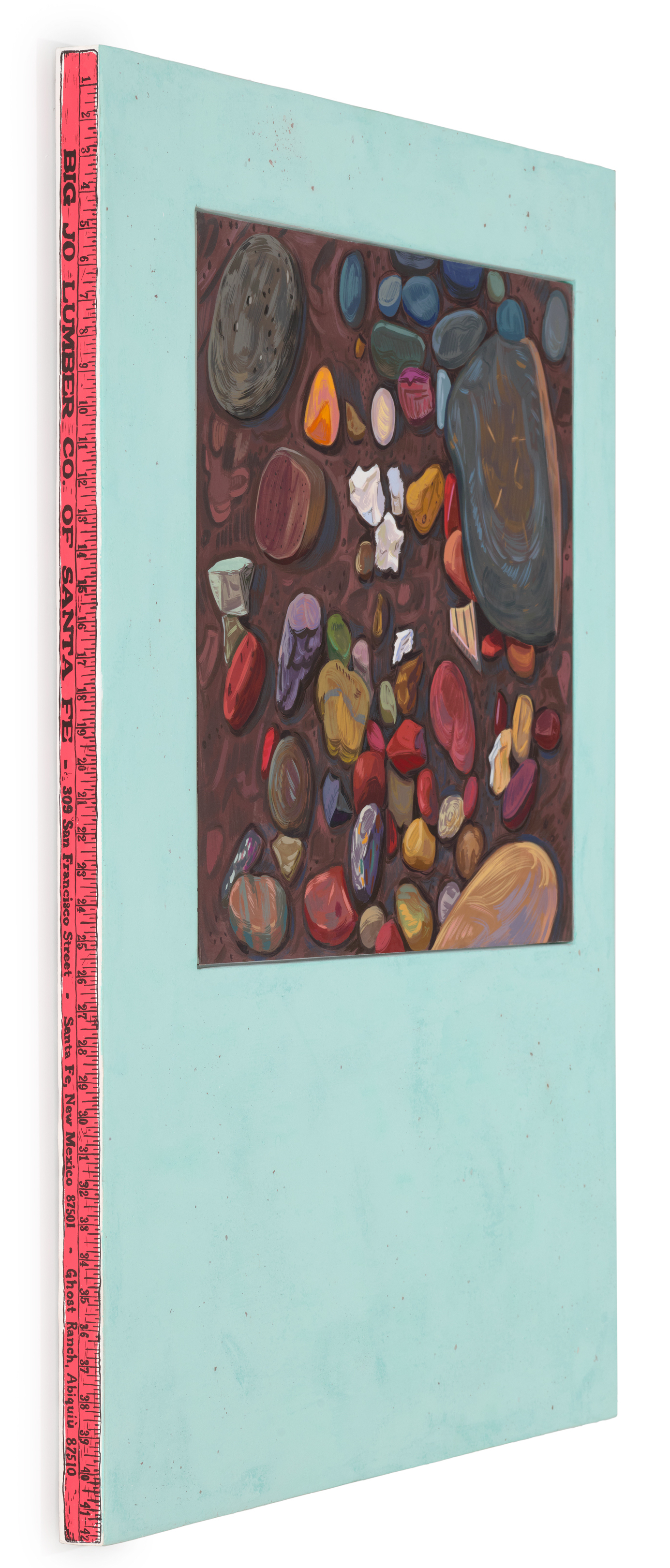
Like O’Keeffe’s paintings executed at Ghost Ranch, Vaccaro’s portraits of the artist can offer panoramic vistas; views of Chimney Rock and the painted cliffs. Halvorson, in contrast, is a painter steadfastly looking where she walks, attentive to the ground not only for the purpose of collecting what she sees, but for capturing it in situ. Eschewing staged subjects, Halvorson trains her vision on the terrain, presenting a pantheistic portrait of nature; not of tall trees and flowers, but of the ground from which these spring. As O’Keeffe would do, with her paintings of individual blossoms, Halvorson invites us to linger upon the overlooked—the ground which we tromp upon but do not see. While the influence of photography has been detected in O’Keeffe’s practice of enlarging, of filling a canvas with a single flower, Halvorson stresses the one-to-one scale of her more recent works. Paintings from the series On the Ground included a screen-printed image of a tape measure as a means of registering and recreating reality. At Ghost Ranch, Halvorson came across O’Keeffe’s pink yardstick, which she has reproduced on six of the paintings in the present catalogue [Figure 6]. Like a stamp or seal, these printed edges denote an authentic relationship to their subject.
Much more than an art museum in the traditional sense, the O’Keeffe Museum is a constellation of sites and collections. This includes a Research Center in Santa Fe, a Welcome Center in Abiquiú, and two historic properties. Only after an initial exploratory visit did Halvorson settle on Ghost Ranch—a spectacular setting not merely to make work out-of-doors, as she had done most recently in the Massachusetts woods, but inside the house as well. This, I supposed, would be a return of sorts to the painting of unoccupied interiors; in this case, not a derelict factory, or abandoned warehouse, but a carefully preserved historic home.
Certainly, Halvorson was no stranger to rarified settings. In 2014, as the first American recipient of the Prix de Rome at the Villa Medici, she had been assigned the former studio of the school’s famous director: Jean-Auguste Dominique Ingres. In the event, the ghost of “monsieur Ingres” had been an inspiration and an impediment. Even the view out the window was one of the most famous in classical French painting: overlooking the Vatican and the dome of St. Peter’s. Stifled by the summer heat and the mantle of an entire European tradition, Halvorson chose to paint at night; setting her easel in front of the window only to paint an invisible view—a window framing a rectangle of darkness [Figure 7]. In this way, Halvorson was able to escape the heaviness of this “hallowed” setting, and engage on her own terms with the opportunity she had been afforded.
At the end of O’Keeffe’s life, she had willed the Ghost Ranch house to her assistant, Juan Hamilton. When the Hamiltons sold the house in 1998, they made a gift to the nascent O’Keeffe Museum of all of its contents. In 2005, the house itself passed to the Museum, and could now be reunited with its contents—staged, in so far as possible, to look the way it had at the end of O’Keeffe’s life. In the meantime, every stone, bone, breakfast bowl, and cook book had been inventoried by the Museum. Indeed, I remember being tasked, on one of my very first visits to the house in 2018, with staging O’Keeffe’s camping gear, which had returned from an exhibition.
It wasn’t until some time into her residency that I shared this memory with Halvorson. It might, however, have prepared her for some of what she would experience as the first person entrusted to make art inside one of the Museum’s most precious holdings. Rather than making her feel like an intruder, however, Halvorson notes that the security protocols and the relationships formed with the staff at the historic houses actually helped forge a connection. Here she was alone, not just in O’Keeffe’s place, but with O’Keeffe’s things, and in dialogue with those who knew her.
This is not to suggest that Ghost Ranch, as a setting, did not impress Halvorson; but when she set up her easel, it was not to paint the Pedernal or the chimney rocks and cliffs. A sense of place is evoked by more impressionistic means, as the sum total of landscape still lifes and vignettes. Some of these, such as a vandalized National Forest sign, recall the imagery of As I Went Walking, and the tension between preservation and property that underlies so much of our interaction with nature.
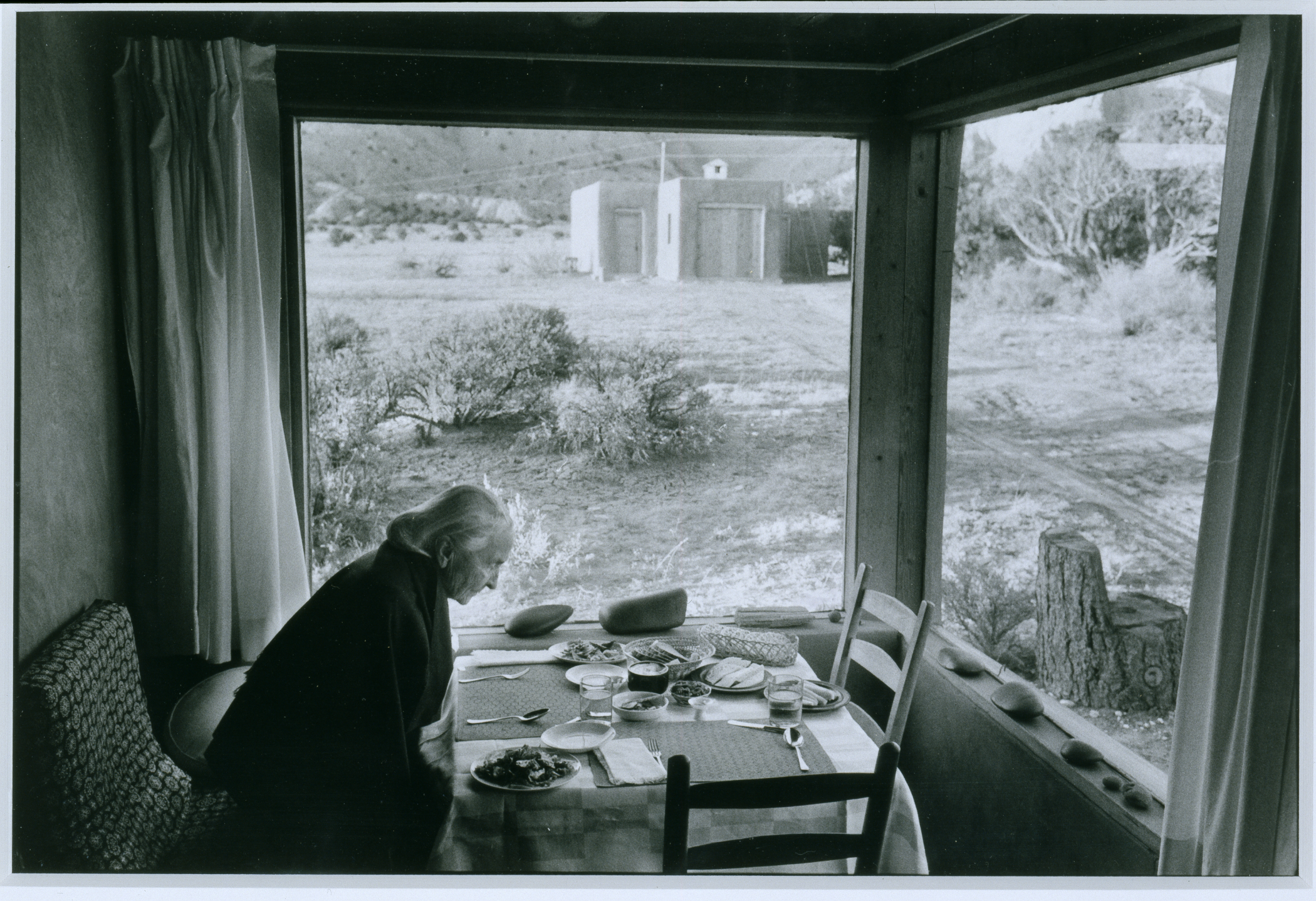
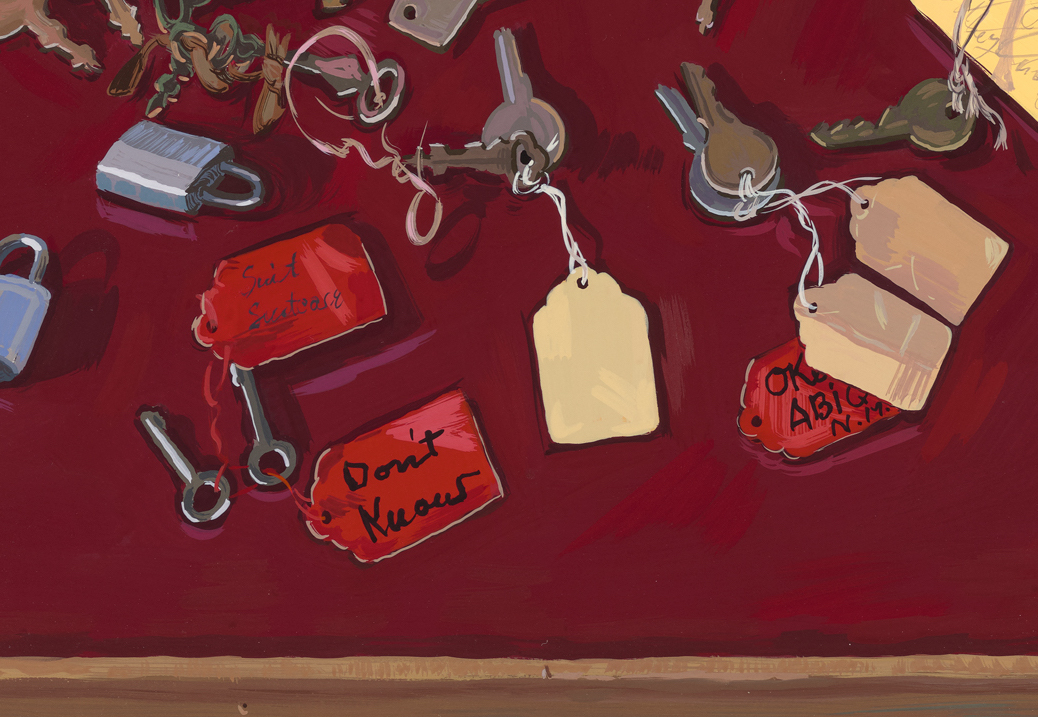
As Halvorson remarks, her lifetime coincided (however briefly) with O’Keeffe’s. It is the sort of thought one has returning, day after day, to someone else’s houses—especially a house that has been so painstakingly preserved. To wit, the efforts of curators like myself “staging” O’Keeffe’s camping gear. The log Halvorson paints is no ordinary stump, but the one Georgia O’Keeffe used as a stool [O’Keeffe’s Tree Stump]; likewise, the mismatched china [O’Keeffe’s Dishes], also inventoried and catalogued by the Museum. The intimacy of the latter subject only increases when we consider the nearby breakfast nook, which O’Keeffe had enclosed, and where she was so often photographed taking breakfast alone [Figure 8]. Similarly, the collection of spare keys painted by Halvorson is made memorable by the handwritten labels affixed by O’Keeffe, including the all-too-human “Don’t know” [Figure 9].
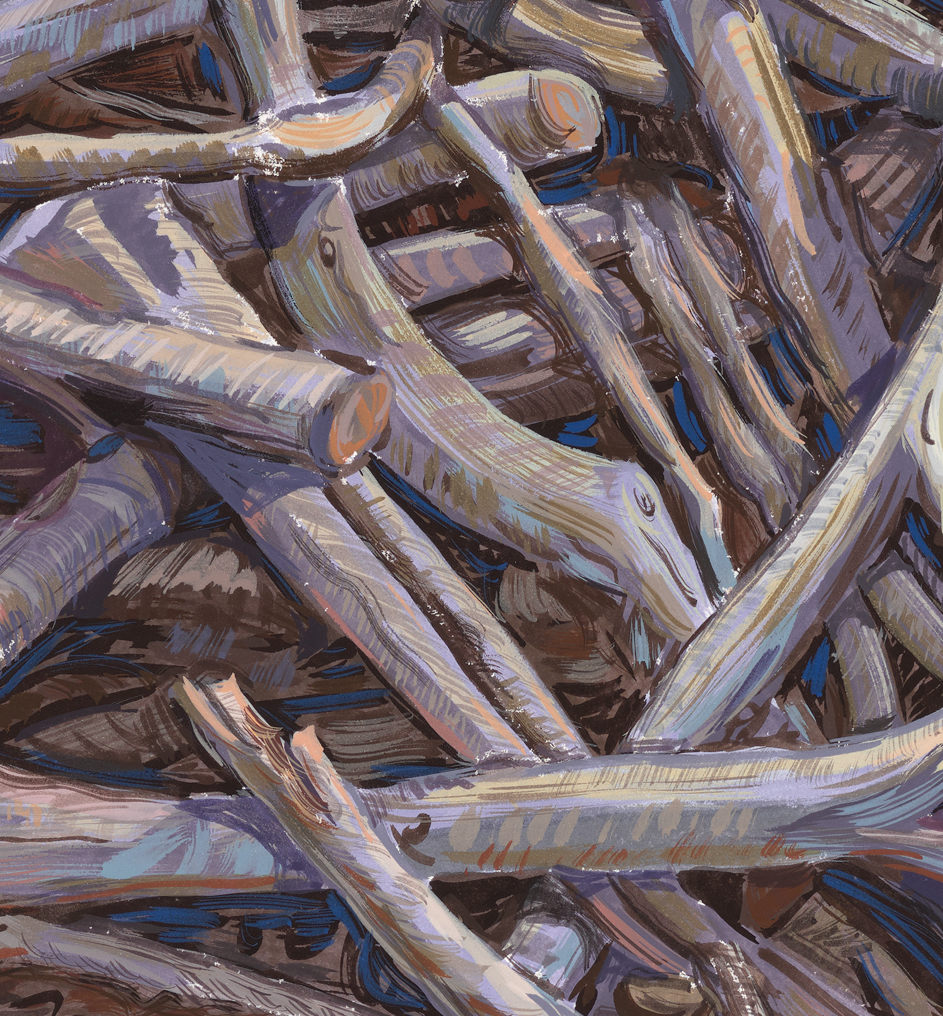
In the interview that accompanies this essay, Halvorson speaks about her practice as it pertains to her choice of materials; most notably, her move away from oil paints in favor of water-based acrylic gouache (the material used to execute the paintings in this catalogue). The opacity of gouache, sometimes called “poster-paint,” lends itself to sign-making and illustration, and there is a decidedly calligraphic quality to Halvorson’s line in these works executed relatively quickly with a fast-drying paint. The opacity of these pigments also favors a certain palette,; a light, pastel tone, which can be appreciated, for instance, in the way Halvorson constructs her shadows, mostly with blues and lavenders [Figure 10]. The indelibility of Halvorson’s notational strokes, rendered in a bright and dusty palette, recall the topography of the Southwest. Indeed, her frames, each a pigmented pastel hue, include fragments of earth and rocks from the sites where the paintings were made.
In a vitrine at the Museum, Halvorson’s earths are presented alongside jars of pigment preserved by O’Keeffe—each labeled in the artist’s hand. Like the raw sienna, burnt umber, and other pigments favored by O’Keeffe, Halvorson’s earth becomes a part of her practice, a further means of grounding her paintings in place. Whether indoors or out-of-doors, Halvorson’s still life subjects remain resolutely site-specific, rooted in the places she has shared with O’Keeffe.
